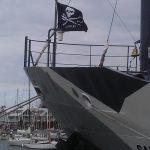 When visiting a Sea Shepherd ship that is moored in my home town I was fascinated to hear the story of how they find the whalers in the Antarctic. It is a great story of working in a complex space, a lovely metaphor for organizations and how to share knowledge.
When visiting a Sea Shepherd ship that is moored in my home town I was fascinated to hear the story of how they find the whalers in the Antarctic. It is a great story of working in a complex space, a lovely metaphor for organizations and how to share knowledge.
They have no idea where to find the whaling ships as these ships wish to remain under the radar so to speak. Sea Shepherd is faced with a huge ocean and all it brings with it. So what to do? They work with narrative fragments. There is a report of sighting of whale intestines, the information on the currents present another story, there has been a serious storm to the south west, there is a congregated flock of birds, the krill are on the move and on it goes. As the narrative emerges, patterns begin to emerge and some basic sense making of these patterns provides knowledge as to where the whalers might be. Inevitably they are right and are able to move towards the whaling fleet and engage in interventions to disrupt their activities. Often the path to the whalers is not direct, but the ships need to move around storms and turbulence or move with a storm in the appropriate direction. A seemingly straight line to the whalers has many twists and curves.
The knowledge derived from the patterns and the sense making is shared by the research ship to the other vessels which are then able to plot their course with the ongoing knowledge about whalers movements and the sea conditions harnessed by the research ship. When they reach the fleet, the disruptive intervention to create change is a shared knowledge initiative. Often this is dangerous and the crews in the Sea Shepherd ships subjected to push back behaviour from the whaling fleet and are often pushed close to exiting. But they achieve change in all this turbulence…….i.e 900 less whales killed this year.
It is a great story and one that can be used metaphorically in organizations or looked at much closely to develop our understanding of complexity, the use of narrative, sensemaking and designing interventions.

